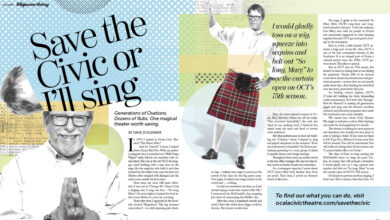His staying power in the culture makes the Beatles seem more like the Starland Vocal Band, yet he is more elusive than the Abominable Snowman or the Loch Ness Monster. His reputation for entering homes of sleeping strangers in the middle of the night has caused no backlash and to this date not a single arrest has been made of this man.
Every person in the Western world could easily pick him out of a police lineup and still no one has stepped forward with any hard evidence to prove his existence.
He, of course, is Santa Claus. And despite the preponderance of imagery, folklore, literature, myth, song and hype surrounding him, Santa’s true identity and purpose remain a mystery to most. Conspiracy theorists claim the guy does not actually exist, but a large portion of the population swears to Santa Claus’ authenticity – for some reason, nearly all of those believers happen to be very short people.
Not even the 21st Century PC Nazis have been able to destroy Santa Claus, who has become such a fixture of Western culture that he has been embraced in some form or fashion by people of nearly every religion, race, ideology and social class. About the only place in the world that ostracizes Claus would be Philadelphia, famous for its sports fans booing his arrival at an Eagles football game. In 2022 though, Claus is expected to fully make his rounds on Christmas Eve with any efforts at his cancellation failing miserably.
His popularity speaks mightily of the power of culture, tradition, commercialism and fantasy.
Because of our curious culture, it’s not at all odd to figure a rotund fellow carrying a sack of toys would intrude every home in the Western world via their chimneys, stuff those toys into socks or under a dead tree dragged indoors and ornamented with lights and various filigree. It’s not at all odd to figure this same invader to leave the residence, but not before imbibing on sweet treats and milk intentionally left out by the owners. And, to think, he travels via a sleigh pulled through the night sky by eight reindeer supposedly drugged by some form of magic dust; well, that’s pretty normal, is it not?
Be it myth or reality, the legend of Santa Claus is much more interesting if not more believable. His origins, however, begin not in the West but in what is now modern-day Turkey. St. Nicholas was a monk born in the year 270, served as Bishop of Myra and was famous for his anonymous nocturnal gift-giving to the “poor, marginalized and, in particular, children,” according to the National Catholic Register. His penchant for philanthropy, anonymous or not, was so legendary that it became a source of inspiration for centuries, especially during the Christmas season. The date of his death, Dec. 6, was and still is celebrated in many countries as a day of giving – a tradition moved to Christmas day in the U.S. and elsewhere to coincide with that holiday.
But St. Nicholas gave to poor children, those in need and wanting for the delights this world has to offer. Fast forward to today when Claus seems to favor the rich kids. As Ray Davies sang, “Give all the toys to the little rich boys.” At this point, the story starts to break down as even the most Pollyannaish of children begin to smell a tinge of rat.
Perhaps Claus is not St. Nicholas after all? The Dutch actually made him famous, referring to him as Sinterklaas and portraying him in his white and red bishop’s liturgical vestments. The name Santa Claus is merely an English translation of Sinterklaas, so maybe the progression of St. Nicholas to Santa Claus holds weight.
So why does a Dutch tradition hold so much sway in the U.S.? We can thank the Puritans for their wet blankets, thrown so obtusely upon the Christmas tradition. Having banned the holiday for its apparent lack of piety and loose pagan origins, the Puritans left it up to the Dutch in the New World, particularly New Amsterdam (now New York, for those who did not pass third-grade history) to carry Christmas forward. And with the holiday’s survival came the survival and revival of Sinterklaas, evolving into Santa Claus and prepped for a grand coronation as the greatest character in mythological history, greater than the Easter Bunny, Tooth Fairy and Great Pumpkin.
Today, images show Santa Claus (Father Christmas, if you are English or at least a fan of The Kinks) as a portly fellow with a long white beard adorned in a red and white winter coat with black boots. But Saint Nicholas was never portrayed this way – so why now and in a country thousands of miles from whence he came? For that, we can thank American writer Clement Clarke Moore, who penned his version of Santa Claus in the famous 1823 poem “A Visit From St. Nicholas” which interestingly enough never uses the words “Santa Claus.”
In the poem, commonly known to most as “The Night Before Christmas,” Clarke describes “St. Nick” as “chubby and plump, a right jolly old elf” and the fat shaming continues to this day. We laugh at his “little round belly” that shakes “like a bowl full of jelly.” We further mock him by enabling his obesity with non-ketogenic cookies and dairy beverages.
Forty years after Moore’s poem, the modern image of Claus would be cast in the minds of Americans thanks to illustrator Thomas Nast. In the Jan. 3, 1863, edition of Harper’s Weekly, Nast not only fat shames Santa Claus, but also uses him for the purposes of propaganda, donning him in stars and stripes at a union encampment while holding a puppet toy with a noose around its neck – the puppet no doubt Confederate President Jefferson Davis.
Now, the country is at a point of no return when it comes to Santa Claus. Politicized and commercialized, fat Santa is with us forever, unless he turns non-binary and stuffs puberty blockers in all the children’s stockings. Ah, then we shall long for the simple past that included mall Santas hawking electronics and overpriced goods to ravenous holiday shoppers.
St. Nicholas himself was neither portly nor jolly, but his image today completely belies the reality of almost 2,000 years ago. His evolution is due mainly to people like Nast and marketing gurus eager to capitalize on the beloved imagery of the jolly fat man.
All this is well and good and to be expected in such a consumer-oriented culture, but how did Claus get to the North Pole, where property taxes fall well below world averages and the political climate is corporate-friendly? In movies, it seems like such a hospitable place, like early November in South Dakota, but in other photos and films taken by journalists and documentarians, the North Pole looks like white death. It would make more sense to build a resort on the moon than to take up residence at either pole.
Again, Nast is to blame. If Claus actually lives there, it is because Thomas Nast succumbed to the zeitgeist of his day when the world was enthralled with expeditions to the Arctic that were taking place during the 1840s and ‘50s. According to Oceanwide Expeditions, “This was no random decision on Nast’s part.” Nast had three reasons for placing his version of Santa Claus in the North Pole: 1. Public imagination had created an almost “mythical” status of the Pole, 2. Reindeer actually live in the Arctic, which was convenient in that it lent credence to his tale, and 3. It snows all year long in the Arctic and snow is symbolic of Christmas.
Poor fellow Claus, to be sentenced to a ghastly frozen tundra and live out a life of servitude, all because Thomas Nast felt it compelling to his story.
Of course, Nast is not alone in crafting the image and re-branding of St. Nicholas. Washington Irving played a role in his A History of New York in 1809 in which he Americanized the Dutch Sinterklaas into “Santa Claus.”
Charles Dickens’ A Christmas Carol in 1843 portrayed Father Christmas as the Ghost of Christmas Present and was part of the merging of the old English version of St. Nicholas with the new versions crafted in America by Irving and Clarke. Then Nast blasted this guy to the nether regions of myth, folklore and even holiday kitsch.
On Dec. 25, 2022, children all over the United States and many other countries will wake up to goodies placed there by St. Nicholas, or Sinterklaas, or Santa Claus, or Father Christmas or whatever suits your fancy. None will catch him in the act, and those who do will likely regret it for the rest of their lives. Not to worry, seeing or touching is not believing in this case. So we turn to the immortal words of Francis Pharcellus Church, who famously wrote, “Yes, Virginia, there is a Santa Claus … how dreary would be the world if there were no Santa Claus. There would be no childlike faith then, no poetry, no romance to make tolerable this existence.”
So who is Santa Claus and what is his purpose? Church’s words say it all despite the cynicism of our age. He exists and is the common ground of a culture that seems to be tearing apart every day as its language is bastardized, its architecture sterilized and its faith minimalized.
As modern technology has led people into a state of withdrawing into themselves and their own enclaves of thought and behavior, Claus has been the common ground of us all. While everything else in the world seems to be dividing humanity, Santa Claus is actually uniting us, and perhaps that is Santa Claus’ purpose after all.






